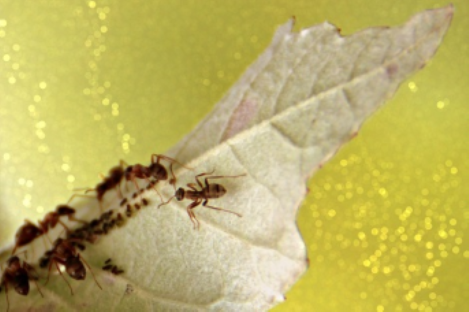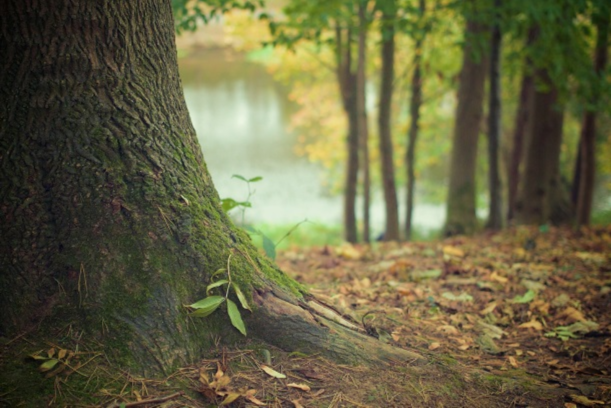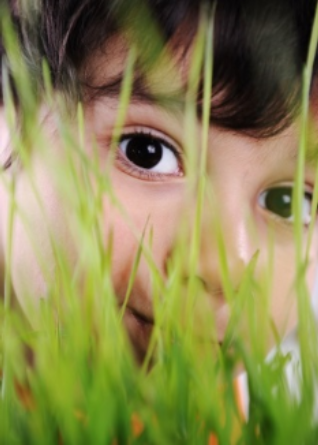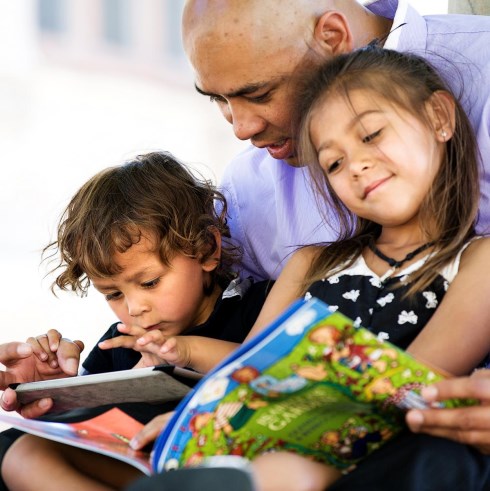Introduction
Children are born scientists. They want to see how things work (observing), guess what will happen if… (predicting), test out their predictions (experimenting), and figure out why things happen as they do (interpreting). Teachers need only to provide the opportunities and materials necessary to find out the answers (i).
Young children learn best when they are able to be involved. The more senses the better. They don’t want to watch a demonstration or hear you tell about it. They learn much more from trying things hands-on, looking at options, making a choice, trying it to see what happens, and then figuring out what to try next than from you talking about it or showing them. Teachers can give a brief set-up for activities and then allow children to explore. This process helps children build self-confidence and critical thinking skills— skills that are important to school success.
In this fact sheet we focus on the living world—the world of animals and plants.

Exploring the World of Animals
Children are naturally curious about the world around them. Animals are a big part of that world. Young children marvel at all the shapes, sizes and colors animals come in; where they live; what they do; and how they move and eat. When allowed to explore the world of animals, they come to appreciate animals and the important role they play in our lives. With an adult as a guide, children can be curious and learn about respecting all living things.
Ideas to Try
Bug Hunt - Give children magnifying glasses and show how to use them. Have children look for different bugs in the play yard. Have them look at the bugs through the magnifying glass. Have them talk about what they see. Keep track of all the different types of bugs children observe. Children can keep an ongoing bug diary. Share a book on the subject, such as Insect Detective by Steve and Charlotte Voake. Teach children to be respectful of insects.
Flying Birds - Observe birds outside or show children pictures or videos of birds flying. Talk about how their wings help them fly. Create armbands from strips of paper, two per child. Older child can cut wings from large sheets of paper; younger children will need help. Tape wings onto arm bands. Play music and let children “fly” around the room like birds.
Make Spiders - Give children a ball of clay, pipe cleaners, paper scraps, and crayons or markers. Use pipe cleaners to make legs for a clay body. Let children draw faces for their spiders if they want. Use the activity to talk about spiders, what they eat, how many legs they have, and how they compare to six-legged insects. Read a book about spiders, such as The Very Busy Spider by Eric Carle.

Watching Ants - Share a book about ants with children, such as Hey, Little Ant by Hannah and Phillip Hoose. Go outside looking for ants. Follow ants to see if children can find their holes. Beforehand, discuss the importance of approaching an anthill carefully to avoid stepping on it or disturbing it. Give children magnifying glasses to watch the ants up close. Observe to see if the ants are carrying anything. Drop a few small cracker crumbs and see what the ants do with the crumbs. Have children try to walk like an ant.
Different Kind of pets - Learn about pets and their homes by reading and discussing the book Franklin Wants a Pet by Paulette Bourgeois and Brenda Clark. Then have the children match pictures of different pets with their homes such as bird-birdcage; fish-fishbowl; dog-doghouse. Talk about different types of pets and play a guessing game. “I'm thinking of a pet that has wings and tweets. What am I?” (bird). “I'm thinking of a pet that has four legs, whiskers and purrs. What am I?” (cat).
Be a Veterinarian - Transform the dramatic play area into a vet's office by adding stuffed animals, doctor kits, clipboards and bandages.
Exploring the World of Plants
For preschoolers, one’s own backyard is a great place to start learning about plants and nature. There is so much to see, so much to learn. How do plants grow? Why are some plants so tall and others so small? Some have thorns, and some have pretty flowers. Some plants we eat but others we don’t. Introducing children to the wonders of plants and nature during the preschool years can launch them to being willing and successful science learners in elementary school.
Ideas to Try
Garden in a Fishbowl - Read a book about how plants grow, such as Planting a Rainbow by Lois Ehlert. Use a small, round fishbowl. Arrange a layer of cotton balls in the bottom. Wet the cotton balls thoroughly; all water should be absorbed by the cotton. Sprinkle bean sprout or grass seeds over the cotton. Cover the bowl with plastic wrap and place it near a window. Watch each day as the seeds begin to sprout. Remove the plastic cover once the sprouts begin to grow. Water as needed.

Bark Rubbings - Give children blank pieces of paper and crayons. Go outside where there are a number of trees. Have children hold their piece of paper against a tree’s bark. Using the long, bare side of a crayon, rub on the paper to create a bark rubbing. Try it on several trees with different types of bark. Compare the feel and look of the bark, and the bark rubbings.
Leaf Handprint Trees - Draw a picture of a tree without leaves on a large sheet of paper. Make sure children have on paint smocks. Put finger paint in trays. Have children place hands in paint and then use their hands to make handprint “leaves” on the tree outline. Teachers may need to help younger children by placing their hands in the paint. Clean children’s hands when finished.
Find That Plant - Ask children what grows outside. Write down their ideas on a large sheet of paper. Take them on a nature walk or to a nearby park. Have them find all the different types of plants they can find—grass, flowers, weeds, moss, bushes, trees, etc. Write their discoveries on a piece of paper. When you get back to the classroom, compare their first list with what they actually found on their walk. Complete the lesson by reading a related book, such as The Tiny Seed by Eric Carle.
Sprouting Indian Corn - Place an ear of Indian corn in a plastic container with just enough water to cover about one-third of the ear. Change the water every couple of days as it will turn murky and mold will appear. Sprouts will grow in several days.


Fun Books to Share
- Andrea Beaty & David Roberts, Ada Twist, Scientist.
- Camille Andros & Brianne Farley, Charlotte the Scientist is Squished.
- Denise Fleming, In the Tall, Tall Grass.
- Paul Meisel, My Awesome Summer by P. Mantis.
- Angela DiTerlizzi, Some Bugs.
- Steve & Charlotte Voake, Insect Detective.
- Eric Carle, The Very Busy Spider.
- Hannah & Phillip Hoose, Little Ant.
- Paulette Bourgeois & Brenda Clark, Franklin Wants a Pet.
- Lois Ehlert, Planting a Rainbow.
Conclusion
Recent studies confirm the importance of introducing children to the natural world, beginning in the early years (ii). Exposure to science and nature not only increases young children’s knowledge, it strengthens their language skills, and their social, emotional and physical health (iii, iv). For preschoolers, learning about what is in one’s own backyard is a great place to start. It is where children can get close and personal with nature. This kind of learning prepares children for the primary grades, when they will deepen their nature knowledge by learning about the world at large.
References & Additional Readings
- Piasta, S. B., Logan, J. R., Pelatti, C. Y., Capps, J. L., & Petrill, S. A. (2015). Professional development for early childhood educators: Efforts to improve math and science learning opportunities in early childhood classrooms. Journal of Educational Psychology, 107(2), 407-422.
- Ward, C. (2014). Connecting young children with nature. Teaching Young Children, 8(1), 24-27.
- Guo, Y., Wang, S., Hall, A. H., Breit-Smith, A., & Busch, J. (2016). The effects of science instruction on young children’s vocabulary learning: A research synthesis. Early Childhood Education Journal, 44(4), 359-367.
- Trundle, K. C., & Smith, M. M. (2017). A hearts-on, hands-on, minds-on model for preschool science learning. YC: Young Children, 72(1), 80-86.
- Heroman, C. (2017). Making and tinkering with STEM: Solving design challenges with young children. National Association for the Education of Young Children.
- NAEYC. (2015). Exploring math and science in preschool. National Association for the Education of Young Children.
Prepared By
Dan Weigel, Child and Family Specialist
Teresa Byington, Early Childhood Development Specialist
YaeBin Kim, Parenting Education and Family Literacy Specialist
Weigel, D., Byington, T., Kim, Y.
2017,
Science in the Preschool Classroom: The Living World - Animals and Plants,
Extension | University of Nevada, Reno, FS-17-09


